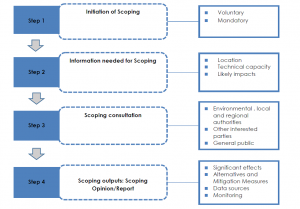Lesson 5 – Scoping step of EIA´s process
Welcome to the e-learning lesson on the scoping step of Environmental Impact Assessment (EIA). In this course, we will learn about the scoping process and its importance in the EIA process.
Scoping is an early stage in the EIA process that determines the content and extent of the information on the key environmental impacts and issues of concern that should be submitted to a competent authority to make an informed decision (Scoping Opinion) about projects subject to EIA.
The main objective of scoping is to ensure that the environmental studies provide all the relevant information on the impact of the project, focusing on the most important impacts, alternatives to the project, and any other matters to be included.
The findings of scoping define the ‘scope’ of the environmental information to be submitted to the competent authority and the terms of reference (ToR) for the environmental studies to be undertaken to compile that information.

Scoping assists in the effective planning, management, and resourcing of the EIA report. It identifies other legislation or regulatory controls that may be relevant to the project and can provide opportunities for the necessary assessment work, for different control systems, to be undertaken in parallel, thereby avoiding the duplication of effort and costs for all concerned.
Scoping should identify the impacts, preliminary alternatives, and scales to the proposed project as well as preliminary mitigating measures that ought to be considered by the developer. The more participative and tailored the scope is, the lower the likelihood that the competent authorities will need to request additional information from the developers after the environmental report has been prepared and submitted for development consent.
This stage provides an opportunity to open a dialogue between the competent authority and the developer about the project and the issues it raises. The competent authorities have to seek advice from the relevant environmental authorities and the local and regional authorities prior to giving a scoping opinion. In many cases, other interested parties and the general public are also given an opportunity to comment on the project proposal.
Scoping is divided into four steps, which include initiation of scoping, the information needed to undertake scoping, scoping consultation, and scoping opinion.
In Step 1 – Initiation of Scoping, scoping can be initiated either by the developer requesting a scoping opinion from the competent authority (voluntary scoping) or can be mandatory, where the competent authority has to give an opinion on the scope of the EIA report.
In Step 2 – Information needed to undertake scoping, the developers must provide to the competent authority with the information on the project in order to prepare a scoping opinion for them. The developer prepares a preliminary document that includes information on the project’s specific characteristics, including the location, technical capacity, and a brief description of the project’s likely impacts on the environment.
Step 3 – Scoping consultation involves consultations with the environmental authorities, local and regional authorities, other interested parties, and the public from the important parts of the process. Consultations help to ensure that all of the key impacts, issues, concerns, and interests are identified and taken into account.
Finally, in Step 4 – Scoping Opinion, the competent authority provides a scoping opinion, which identifies the content and extent of the information to be elaborated in the EIA report. The scoping opinion defines the scope of the environmental information to be submitted to the competent authority and the terms of reference (ToR) for the environmental studies to be undertaken to compile that information.